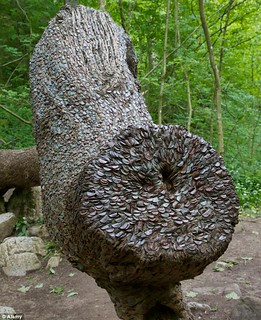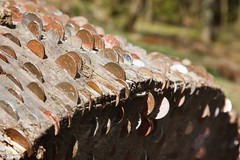
PREV ARTICLE
NEXT ARTICLE
FULL ISSUE
PREV FULL ISSUE
THE COIN-TREE IN BRITAIN AND IRELAND
Kavan Ratnatunga forwarded this interesting study by C. Houlbrook about the ritual usage of coins in past, from the Post-Medieval Archaeology journal. Thanks! Here's a small excerpt from the Abstract and Introduction. The complete paper runs 29 pages. Alas, the online version does not include illustrations. To compensate, I've included images from an earlier E-Sylum article about 'Wishing trees' forwarded by Stephen Pradier.
-Editor
Houlbrook, C. 2015.
‘Money is what money does,’ declares economist David Wolman. And what money does is act as a means of declaring value and facilitating fair exchange. However, such a use is certainly not limited to the secular realm. The history of British coinage can be traced back two millennia, to some point during the first century BC, and throughout much of this period coins have been imbued with value that transcends economic worth. For most of their history in Britain, they have been ritually employed and perceived of as possessing preternatural powers. A notable example is the coin’s appropriation as a votive offering, e arly examples of which include the Hallaton Hoard (East Leicestershire). This consisted of over 5000 coins mostly dating between c. AD 20-50, having been deposited at a site which is believed to have been an open-air gathering place with possible ceremonial significance. Another early, oft-cited example is the accumulation of coins at the Roman fort of Carrawburgh on Hadrian’s Wall, where between 15,000 and 20,000 coins were recovered from the sacred well of the nymph Coventina, their dates ranging from the reign of August (27 BC – 14 AD) to the late fourth or early fifth century. Indeed, votive coins have been discovered at numerous sites throughout Roman Britain, and as an offering at Christian sites, the coin is equalled in popularity only by the candle. The coin was an object regularly deposited in springs and lakes, as offerings to deities or as propitiatory ‘sacrifices’ to malignant water spirits, and this custom developed into the holy well, into which coins were often thrown as ‘payment’ to the presiding spirit or saint. This custom has survived today in the form of the ‘wishing well’, a tradition now so widespread that they are found in public parks, shopping centres, and popular tourist sites.
For those readers unfamiliar with the term, a coin-tree is exactly what its name would suggest: a tree (occasionally a living specimen, but most often a log or a stump) which has coins inserted edgeways into its bark (Figures 1-2). Thus far, I have catalogued thirty-two active coin-tree sites – active insofar as people today are participating in the custom of inserting their coins into the trees. They are distributed widely across the British Isles and contain a total of 237 coin-trees between them (Map 1 and Table 1). These sites are always in rural areas accessible to the public and are usually located alongside popular woodland or riverside footpaths. The earliest known coin-tree is an uprooted oak (Quercus) on Isle Maree, Loch Maree, in the Northwest Highlands of Scotland (Figure 3). The first reference to a tree’s employment in a folkloric custom on Isle Maree comes from Thomas Pennant’s 1775 A tour in Scotland and voyage to the Hebrides, in which he describes a holy well located on the island, consecrated by Saint Maelrubha – also known as Saint Maree – in the eighth century and widely purported to cure insanity. Beside the well was a tree which, at the time Pennant was writing in the 1770s, was being utilized as an ‘altar’; pilgrims who sought a cure from the holy well would deposit their tokens of thanks to Saint Maree on this particular tree. In 1877 the tree was visited by Queen Victoria on her tour of Scotland, and her party inserted some coins themselves – although by this point, the coin was simply viewed as an offering to St. Maree rather than as a bid for the cure of insanity. Queen Victoria described the tree in her diary, in an entry dated 17 September 1877, as follows: The boat was pushed onshore, and we scrambled out and walked through the tangled underwood and thicket of oak, holly, beech, etc., which covers the islet, to the well, now nearly dry which is said to be celebrated for the cure of insanity. An old tree stands close to it, and into the bark of this it is the custom, from time immemorial, for everyone who goes there to insert with a hammer a copper coin, as a sort of offering to the saint who lived there in the eighth century … We hammered some pennies into the tree, to the branches of which there are also rags and ribbons tied.
To read the complete article, see:
The Numismatic Bibliomania Society is a non-profit organization promoting numismatic literature. See our web site at coinbooks.org. To submit items for publication in The E-Sylum, write to the Editor at this address: whomren@gmail.com To subscribe go to: https://my.binhost.com/lists/listinfo/esylum All Rights Reserved. NBS Home Page Contact the NBS webmaster 
|

